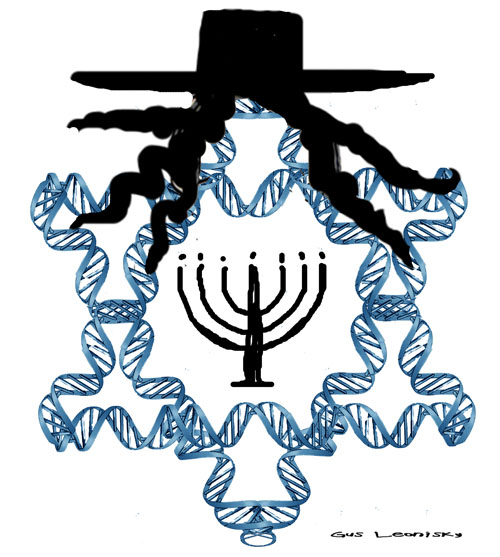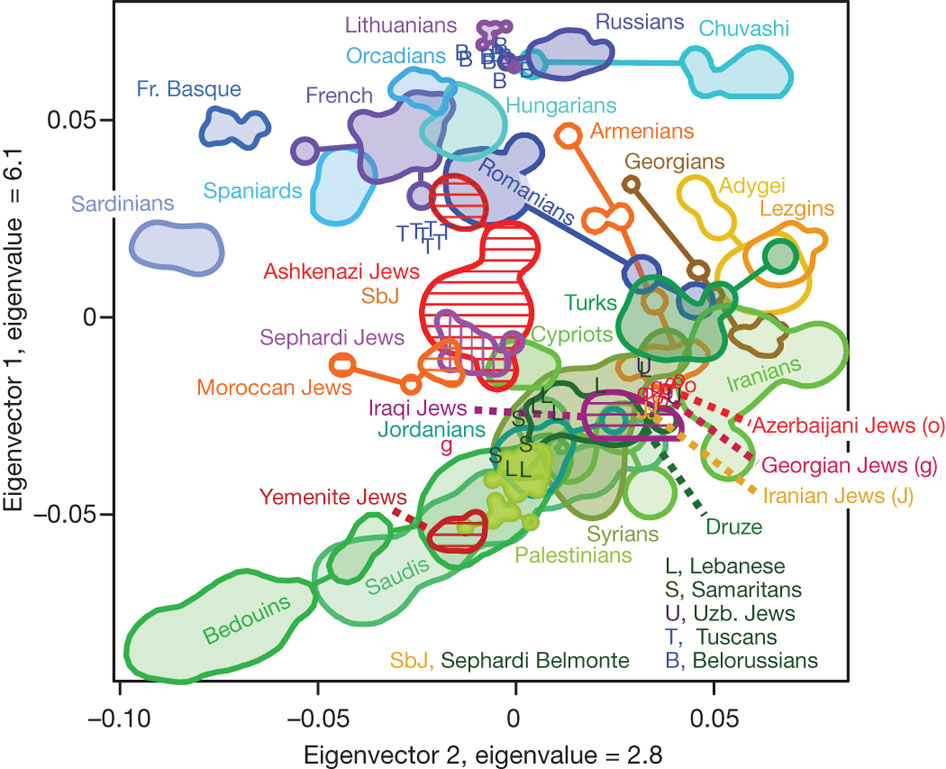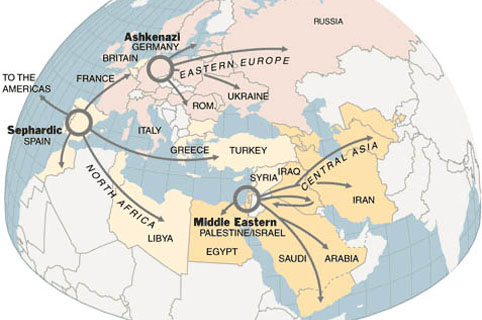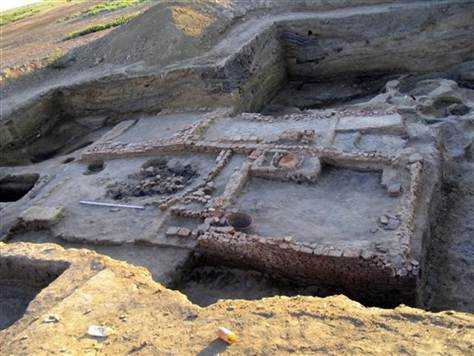


History of Zionism
Zionism as an organized movement is generally considered to have been fathered by Theodor Herzl in 1897; however the history of Zionism began earlier and related to Judaism and Jewish history. The Hovevei Zion, or the Lovers of Zion, were responsible for the creation of 20 new Jewish settlements in Palestine between 1870 and 1897.
Before the Holocaust the movement’s central aims were the creation of a Jewish National Home and cultural centre in Palestine by facilitating Jewish migration. After the Holocaust, the movement focussed on creation of a “Jewish state” (usually defined as a secular state with a Jewish majority), attaining its goal in 1948 with the creation of Israel.
The precedence for Jews to return to their ancestral homeland, motivated by strong divine intervention, first appears in the Torah, and thus later adopted in the Christian Old Testament. After Jacob and his sons had gone down to Egypt to escape a drought, they were enslaved and became a nation. Later, as commanded by God, Moses went before Pharaoh, demanded, “Let my people go!” and foretold severe consequences, if this was not done. Torah describes the story of the plagues and the Exodus from Egypt, which is estimated at about 1400 BCE, and the beginning of the journey of the Jewish People toward the Land of Israel. These are celebrated annually during Passover, and the Passover meal traditionally ends with the words “Next Year in Jerusalem.”
The theme of return to their traditional homeland came up again after the Babylonians conquered Judea in 641 BCE and the Judeans were exiled to Babylon. In the book of Psalms (Psalm 137), Jews lamented their exile while Prophets like Ezekiel foresaw their return. The Bible recounts how, in 538 BCE Cyrus the Great of Persia conquered Babylon and issued a proclamation granting the people of Judah their freedom. 50,000 Judeans, led by Zerubbabel returned. A second group of 5000, led by Ezra and Nehemiah, returned to Judea in 456 BCE.
In 1160 David Alroy led a Jewish uprising in Kurdistan that aimed to reconquer the promised land. In 1648 Sabbatai Zevi from modern Turkey claimed he would lead the Jews back to Israel. In 1868 Judah ben Shalom led a large movement of Yemenite Jews to Israel. A dispatch from the British Consulate in Jerusalem in 1839 reported that “the Jews of Algiers and its dependencies, are numerous in Palestine….” There was also significant migration from Central Asia (Bukharan Jews).
In addition to Messianic movements, the population of the Holy Land was slowly bolstered by Jews fleeing Christian persecution especially after the Reconquista of Al-Andalus (the Muslim name of the Iberian Peninsula). Safed became an important center of Kabbalah. Jerusalem, Hebron and Tiberias also had significant Jewish populations.
Among Jews in the Diaspora Eretz Israel was revered in a religious sense. They thought of a return to it in a future messianic age. Return remained a recurring theme among generations, particularly in Passover and Yom Kippur prayers, which traditionally concluded with “Next year in Jerusalem”, and in the thrice-daily Amidah (Standing prayer).
Jewish daily prayers include many references to “your people Israel”, “your return to Jerusalem” and associate salvation with a restored presence in Israel and Jerusalem (usually accompanied by a Messiah); for example the prayer Uva Letzion (Isaiah 59:20): “And a redeemer shall come to Zion…” Aliyah (immigration to Israel) has always been considered a praiseworthy act for Jews according to Jewish law and some Rabbis consider it one of the core 613 commandments in Judaism.
From the Middle Ages and onwards, many famous rabbis (and often their followers) immigrated to the Land of Israel. These included Nahmanides, Yechiel of Paris with several hundred of his students, Joseph ben Ephraim Karo, Menachem Mendel of Vitebsk and 300 of his followers, and over 500 disciples (and their families) of the Vilna Gaon known as Perushim, among others.
Persecution of Jews played a key role in preserving Jewish identity and keeping Jewish communities transient, it would later provide a key role in inspiring Zionists to reject European forms of identity.
Restoration of the Jews to the Holy Land

Thus, Judaism is a mosaic of culture, religion, ethnicity, and for some, a way of life. It is an identity that is not quite a nationality, but neither is it a simple ethnic or cultural phenomenon either. This unusual combination of characteristics, coupled with Jewish resistance over the centuries to assimilation and strong adherence to their religious faith, has contributed to the intense feelings of curiosity, hatred, admiration, attraction and hostility by the rest of the world.

A sprawling desert prison, for thousands of refugees
Israel confirms plan to deport African migrants to Uganda

Russian-speakers who want to make aliya could need DNA test
The nearly one million immigrants from the former Soviet Union who have come to Israel since 1989 “rescued” the country and should be considered “one of the greatest miracles that happened to the state,” Prime Minister Binyamin Netanyahu told.
Israelis Re-examine Russian Aliyah
Jewish Supremacists in America are 100 percent united in demanding “open borders” and “immigration reform” — but at the same time hypocritically support Israel which now uses DNA tests on potential immigrants in order to keep the Jewish state racially pure.
Finally, Israel has recently announced that it is to start testing immigrants for Jewish DNA before allowing them to settle in Israel. This significant move (because it confirms a biological basis to Judaism) came about because of concern in Israel over suspected non-Jews entering Israel from the former Soviet Union countries.
Israel, therefore, has a completely racially-based immigration policy, and only allows people of biological Jewish descent to immigrate to that nation.
This policy is directly contradictory to the position taken by Jewish groups in America and other European nations—yet these same Jewish organizations will defend Israel to the last.
To put this into perspective: If America, or any nation for that matter, had to adopt racially based immigration policies and check the DNA of potential immigrants before allowing them to settle, these Jewish organizations would be up in arms and screaming “Nazi” and “holocaust” from the rooftops.
Yet Israel can adopt such policies without anyone raising so much as a peep of protest. On the contrary, these same Jewish organizations will fanatically support Israel’s “right to be a Jewish state.”
Israel—which all of these Jewish organizations and individuals quoted above support fanatically—an immigration policy which is the exact opposite is rigorously enforced.
Israel’s “Law of Return” immigration policy is actually based upon the Nazi Nuremburg race laws, which defined a Jew as anyone with two or more Jewish grandparents.
This law of return is not based on religion—because Jewish atheists also qualify for settlement in Israel. They do not have to be believing Jews to come to Israel—all they have to have is biological Jewish ancestry.

Israel Civil Marriage Ban Blocks Those Not Considered Jewish From Wedding



Despite being one of the most genetically analysed groups, the origin of European Jews has remained obscure. However, a new study published online January 17 in the journal Genome Biology and Evolution by Dr Eran Elhaik, a geneticist at the Johns Hopkins School of Public Health, argues that the European Jewish genome is a mosaic of Caucasus, European, and Semitic ancestries, setting to rest previous contradictory reports of Jewish ancestry. Elhaik’s findings strongly support the Khazarian Hypothesis, as opposed to the Rhineland Hypothesis, of European Jewish origins. This could have a major impact on the ways in which scientists study genetic disorders within the population.
New Study Sheds Light On the Origin of the European Jewish Population
Ashkenazi Jews are probably not descended from the Khazars

The Jewish people’s ultimate treasure hunt

|
|
Who should possess the land of Israel? Christian evangelicals say it should be the descendants of Abraham. They point to the Old Testament and claim that God gave this land forever to the descendants of Abraham and that God demands they and they alone own the land.
To the Christian evangelical, this means the Jews. Yes, it is the Jews who own this land, and it is their land forever.
|
| In 2008, Russian archaeologist Dmitry Vasilyev unearthed Itil, the long lost capital of the Kingdom of Khazaria. New DNA science proves that today’s “Jews” come from Khazaria and are not the seed of Abraham. |
The Jews, then, according to Christian evangelicals, are the descendants of Abraham, his seed.
DNA Science Confounds the Common Wisdom
There is only one problem. And it is a huge one. Science proves those who call themselves “Jews” are not Jews! DNA Science has confounded the Christian evangelicals by proving conclusively that most of the people in the nation of Israel and in World Jewry are not the descendants of Abraham.
Those living today who profess to be “Jews” are not of the ancient Israelites, and they are not the seed of Abraham. In fact, the new DNA research shows that the Palestinians actually have more Israelite blood than do the “Jews!”
The nation of Israel today is populated with seven and half million imposters.
“Jews” Are Not Descendants of Abraham – Power of Prophecy
The American people are confused about the morality of modern-day Israel, because our schools and churches leave out essential Jewish history.
The European people who were shipped in to occupy Palestine as a Jewish homeland in 1948 are not related to the biblical Hebrews of Jesus’ time.
The biblical Hebrews are symbolized by the Cain and Abel story, brothers who fell out with each other and whose lineage became the two factions we know as Jews and Arabs. But Jews and Arabs are both biologically Semitic people – they are cousins — and despite their “family feud, they are anciently related by blood and culture.
Later on, Jews and Arabs became even more seemingly disparate due to the introduction of Islam. One tribe kept their Judaism, while the other became Muslim, and there is what we’ve perceived as the warring factions of today.
But what has been purposely obscured is a third element that entered and has inflamed the Middle East ever since. It was European Jewish people who were brought in after WWII for the purpose of occupying much of Palestine and resurrecting the ancient name of Israel. This was a political agenda, not a humanitarian intention.
These Europeans had long ago emerged from Khazaria (southern Russia), where their king – for the purpose of greater, unified control – converted them to the Babylonian schools of Judaism in the 8th century. Thus, not only their DNA, but their perspectives are a different reality from the Judean teachings in Jesus’ world.
What we have in modern Israel, then, is an artificially created state dominated by Jews who have no geographic, genetic, nor spiritual connections to biblical Israel or the time of Jesus.
Once this is known — and churches and schools ought to be honest about it — then it’s much easier to understand what many world voices have long cried out: That today’s Israelis who came in from Europe in 1948 did not really have a right to occupy the Palestinian area and re-name it as ancient-days Israel – especially since the Palestinian residents’ families and lands – and even some of their homes that might be still standing – go back over a thousand years.
Modern Israelis simply have no actual connection to the land, to regional traditions, or to the time of Christ. And Christians and Jews who are properly informed – and who are ethical – need to join in the heartfelt objection to the 1948 (and ongoing) usurpation of the Palestinians’ land.
Most especially what is morally required is the cessation of all the cruelties against the Palestinians that have inevitably followed. As President Harry Truman observed right from the beginning of the creation of this modern, artificial Israel:
August 23, 1947, letter to Eleanor Roosevelt –
“I fear very much that the Jews are like all underdogs. When they get on top, they are just as intolerant and cruel as the people were to them when they were underneath. I regret this situation very much because my sympathy was always on their side.”


-
-
Dr Sand’s main argument is that until little more than a century ago, Jews thought of themselves as Jews only because they shared a common religion. At the turn of the 20th century, he said, Zionist Jews challenged this idea and started creating a national history by inventing the idea that Jews existed as a people separate from their religion. Equally, the modern Zionist idea of Jews being obligated to return from exile to the Promised Land was entirely alien to Judaism, he added.
Shlomo Sand: ‘When and How Was the Jewish People Invented?’
How Shlomo Sand Ceased to be a Jew – or Did He?
Book review: Shlomo Sand’s “The Invention of the Jewish People
DNA links prove Jews are a ‘race,’ says genetics expert


Conjuring fear of Nazism and anti-Semitism, Jews recoil from the thought that Judaism might be a race, but medical geneticist Harry Ostrer insists the ‘biological basis of Jewishness’ cannot be ignored. In his new book, “Legacy: A Genetic History of the Jewish People,” Harry Ostrer, a medical geneticist and professor at Albert Einstein College of Medicine in New York, claims that Jews are different, and the differences are not just skin deep. Jews exhibit, he writes, a distinctive genetic signature. Considering that the Nazis tried to exterminate Jews based on their supposed racial distinctiveness, such a conclusion might be a cause for concern. But Ostrer sees it as central to Jewish identity.
“Who is a Jew?” has been a poignant question for Jews throughout our history. It evokes a complex tapestry of Jewish identity made up of different strains of religious beliefs, cultural practices and blood ties to ancient Palestine and modern Israel. But the question, with its echoes of genetic determinism, also has a dark side.
Geneticists have long been aware that certain diseases, from breast cancer to Tay-Sachs, disproportionately affect Jews. Ostrer, who is also director of genetic and genomic testing at Montefiore Medical Center, goes further, maintaining that Jews are a homogeneous group with all the scientific trappings of what we used to call a “race.”
Scientists usually don’t call each other “liars” and “frauds.” But that’s how Johns Hopkins University post-doctoral researcher Eran Elhaik describes a group of widely respected geneticists, including Harry Ostrer, professor of pathology and genetics at Yeshiva University’s Albert Einstein College of Medicine and author of the 2012 book “Legacy: A Genetic History of the Jewish People.”
For years now, the findings of Ostrer and several other scientists have stood virtually unchallenged on the genetics of Jews and the story they tell of the common Middle East origins shared by many Jewish populations worldwide. Jews — and Ashkenazim in particular — are indeed one people, Ostrer’s research finds.
It’s a theory that more or less affirms the understanding that many Jews themselves hold of who they are in the world: a people who, though scattered, share an ethnic-racial bond rooted in their common ancestral descent from the indigenous Jews of ancient Judea or Palestine, as the Romans called it after they conquered the Jewish homeland. But now, Elhaik, an Israeli molecular geneticist, has published research that he says debunks this claim. And that has set off a predictable clash.
DNA links prove Jews are a ‘race,’ says genetics expert
Israeli Newspaper Admits: Jews are a Race
‘Jews a Race’ Genetic Theory Comes Under Fierce Attack by DNA Expert
Top Israeli scientist says Ashkenazi Jews came from Khazaria, not Palestine
Genetic Roots of the Ashkenazi Jews
Genetic studies on the Jews

Jews and Race: A Pre-Boasian Perspective


The Taranto-Capouya-Crespin Family History – Sephardic Horizons
A capsule history of the dispersion of the Jews to the distant cities of the earth


Moment Magazine’s great (Jewish) DNA experiment

-
Jon Entine author of Abrahams Children: Race, Identity and DNA of the Chosen People
Reviews and Testimonials for Jon’s Keynotes

The J2 DNA Kohanim Migration
Genetic studies on the Jews are part of population genetics. This discipline is used to better understand the chronology of migration and thus complements the results provided by history, archeology, language or paleontology. The interest of these studies is to investigate the origins of various Jewish populations today. In particular, they investigate whether there is a common genetic heritage among various Jewish populations.
Since the 1970s, many studies have attempted to determine whether, despite the complex history of migrations, common ancestors existed to the present Jewish communities or if the descendants are related instead to the non-Jewish populations where they lived. The earlier studies tried to answer this question using “classic” genetic markers (blood groups, enzymes, etc.).
Contradictory answers were given according to locus used. One explanation for these contradictions is that the variations associated with a locus are influenced by natural selection. Since the late 1980s and especially since the beginning of the century, geneticists have worked on analysis of the Y chromosome (transmitted from father to son) and mitochondrial DNA (transmitted from mother to child), which have the characteristic to be transmitted in full (without recombination).
It is possible to trace the common direct-line ancestral populations of various peoples of the world. Recent studies have been conducted on a large number of genes homologous chromosomes or autosomes (all chromosomes except chromosomes X and Y).. A 2009 study was able to genetically identify individuals with full or partial Ashkenazi Jewish ancestry.
Wells identified the haplogroup of the Canaanites as haplogroup J2. The National Geographic Genographic Project linked haplogroup J2 to the site of Jericho, Tel el-Sultan, ca. 8500 BCE and indicated that in modern populations, haplogroup J2 is found in the Middle East, North Africa and Southern Europe, with especially high distribution among present-day Jewish populations (30%), Southern Italians (20%), and lower frequencies in Southern Spain (10%).
Cruciani in 2007 found E1b1b1a2 (E-V13) [one from Sub Clades of E1b1b1a1 (E-V12)] in high levels (>10% of the male population) in Turkish Cypriot and Druze Arab lineages. Recent genetic clustering analyses of ethnic groups are consistent with the close ancestral relationship between the Druze and Cypriots, and also identified similarity to the general Syrian and Lebanese populations, as well as a variety of Jewish lineages (Ashkenazi, Sephardi, Iraqi, and Moroccan) (Behar et al 2010).
A study published by the National Academy of Sciences found that “the paternal gene pools of Jewish communities from Europe, North Africa, and the Middle East descended from a common Middle Eastern ancestral population”, and suggested that “most Jewish communities have remained relatively isolated from neighbouring non-Jewish communities during and after the Diaspora”. Researchers expressed surprise at the remarkable genetic uniformity they found among modern Jews, no matter where the diaspora has become dispersed around the world.[
Other Y-chromosome findings show that the world’s Jewish communities are closely related to Kurds, Syriacs, Assyrians, Jordanians and Palestinians. Skorecki and colleague wrote that “the extremely close affinity of Jewish and non-Jewish Middle Eastern populations observed … supports the hypothesis of a common Middle Eastern origin”. According to another study of the same year, more than 70% of Jewish men and half of the Arab men (inhabitants of Israel and the occupied territories only) whose DNA was studied inherited their Y-chromosomes from the same paternal ancestors who lived in the region within the last few thousand years.
This research has suggested that, in addition to Israelite male, significant female founder ancestry might also derive from the Middle East-with 40% of Ashkenazim descended from four women lived about 2000–3000 years ago in the Middle East. In addition, Behar (2006) suggested that the rest of Ashkenazi mtDNA is originated from about 150 women, most of those were probably of Middle Eastern origin.
In August 2012, Dr. Harry Ostrer in his book Legacy: A Genetic History of the Jewish People, summarized his and other work in genetics of the last 20 years, and concluded that all major Jewish groups share a common Middle Eastern origin. Ostrer also claimed to have refuted any large-scale genetic contribution from the Turkic Khazars.
Citing Autosomal DNA studies, Nicholas Wade estimates that “Ashkenazic and Sephardic Jews have roughly 30 percent European ancestry, with most of the rest from the Middle East.” He further noticed that “The two communities seem very similar to each other genetically, which is unexpected because they have been separated for so long.”
Concerning this relationship he points to Atzmon conclusions that “the shared genetic elements suggest that members of any Jewish community are related to one another as closely as are fourth or fifth cousins in a large population, which is about 10 times higher than the relationship between two people chosen at random off the streets of New York City”
Concerning North African Jews, Autosomal genetic analysis in 2012 revealed that North African Jews are genetically close to European Jews. This findings “shows that North African Jews date to biblical-era Israel, and are not largely the descendants of natives who converted to Judaism,”
Y DNA studies examine various paternal lineages of modern Jewish populations. Such studies tend to imply a small number of founders in an old population whose members parted and followed different migration paths.
In most Jewish populations, these male line ancestors appear to have been mainly Middle Eastern. For example, Ashkenazi Jews share more common paternal lineages with other Jewish and Middle Eastern groups than with non-Jewish populations in areas where Jews lived in Eastern Europe, Germany and the French Rhine Valley. This is consistent with Jewish traditions in placing most Jewish paternal origins in the region of the Middle East.
The maternal lineages of Jewish populations, studied by looking at mitochondrial DNA, are generally more heterogeneous. Scholars such as Harry Ostrer and Raphael Falk believe this indicates that many Jewish males found new mates from European and other communities in the places where they migrated in the diaspora after fleeing ancient Israel. Behar et al. in 2008 published evidence suggesting that about 40% of Ashkenazi Jews originate maternally from just four female founders, who were of Middle Eastern origin, while the populations of Sephardi and Mizrahi Jewish communities “showed no evidence for a narrow founder effect”.
Evidence for female founders has been observed in other Jewish populations. With the exception of Ethiopian and Indian Jews, it has been argued that all of the Jewish populations have mitochondrial genomes that were of Middle Eastern origin.
In 2013, Richards et al. to the contrary published work suggesting that an estimated “80 percent of Ashkenazi maternal ancestry comes from women indigenous to Europe, and 8 percent from the Near East, with the rest uncertain”. Apparently, in this case, Jewish males migrated to Europe and took new wives from the local population, and converted them to Judaism.
Studies of autosomal DNA, which look at the entire DNA mixture, have become increasingly important as the technology develops. They show that Jewish populations have tended to form relatively closely related groups in independent communities, with most in a community sharing significant ancestry in common.
For Jewish populations of the diaspora, the genetic composition of Ashkenazi, Sephardi, and Mizrahi Jewish populations show a predominant amount of shared Middle Eastern ancestry. According to Behar, the most parsimonious explanation for this shared Middle Eastern ancestry is that it is “consistent with the historical formulation of the Jewish people as descending from ancient Hebrew and Israelite residents of the Levant” and “the dispersion of the people of ancient Israel throughout the Old World”.
North African, Italian and others of Iberian origin show variable frequencies of admixture with non-Jewish historical host populations among the maternal lines. In the case of Ashkenazi and Sephardi Jews (in particular Moroccan Jews), who are apparently closely related, the non-Jewish component is mainly southern European. Behar et al. have remarked on an especially close relationship to modern Italians.
The studies show that the Bene Israel and Black Cochin Jews of India, Beta Israel of Ethiopia, and a portion of the Lemba people of southern Africa, while more closely resembling the local populations of their native countries, have some ancient Jewish descent.
Y-DNA haplogroups by populations of Near East
Archaeogenetics of the Near East
The “mystery” of Ashkenazic origins
Analysis of Ashkenazi Jewish genomes
Two major groups of living Jews
Dienekes Population Portrait for West Asians and Jews
Ashkenazi Jewish matrilineages

Ashkenazi Jewish matrilineages mainly of European origin
Filed under: Eastern Mediterrean, Haplogroups

